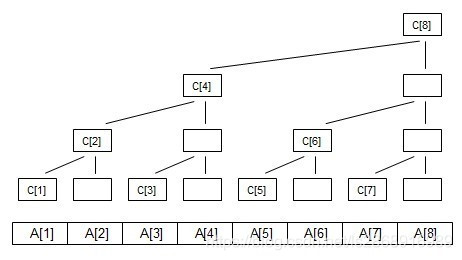
Binary Indexed Tree

Binary Indexed Tree
树状数组
在了解树状数组之前,我们需要对前缀和有一定的了解,具体可以见——prefix_sum_algorithm - Charles’s Castle (charles2530.github.io),树状数组的相关操作可以理解为是树上的前缀和操作。
定义
树状数组或二叉索引树(Binary Indexed Tree),又以其发明者命名为 Fenwick 树。其初衷是解决数据压缩里的累积频率的计算问题,现多用于高效计算数列的前缀和、区间和。它可以以 O(logn) 的时间得到任意前缀和。并同时支持在 O(logn) 时间内支持动态单点值的修改。空间复杂度 O(n)。
树状数组是一个查询和修改复杂度都为log(n)的数据结构。主要用于数组的单点修改&&区间求和,另外一个拥有类似功能的是线段树。
线段树和树状数组的区别
具体区别和联系如下:
- 1.两者在复杂度上同级, 但是树状数组的常数明显优于线段树, 其编程复杂度也远小于线段树.
- 2.树状数组的作用被线段树完全涵盖, 凡是可以使用树状数组解决的问题, 使用线段树一定可以解决, 但是线段树能够解决的问题树状数组未必能够解决.
- 3.树状数组的突出特点是其编程的极端简洁性, 使用
lowbit技术可以在很短的几步操作中完成树状数组的核心操作,其代码效率远高于线段树。
树状数组的优缺点
-
优点:修改和查询操作复杂度于线段树一样都是
O(logn),但是常数比线段树小,并且实现比线段树简单 -
缺点:扩展性弱,线段树能解决的问题,树状数组不一定能解决.
树状数组的应用

1.核心操作lowbit
1 | int lowbit(int x) { |
2.区间查询getSum
1 | int getSum(int x) { |
3.单点更新update
1 | void update(int x, int value){ |
4.区间最大值和最小值 getMax / getMin
题解补充,较冷门,注意使用时也需要修改update函数
1 | int lowbit(int x) { |
其实树状数组还可以进行区间修改区间查询操作,但这类题目建议使用线段树。
总结
树状数组的重点就是利用二进制的变化,动态地更新树状数组。
树状数组的每一个节点并不是代表原数组的值,而是包含了原数组多个节点的值。所以在更新A[1]时需要将所有包含A[1]的C[i]都加上val这也就利用到了二进制的神奇之处。
如果是更新A[i]的值,则每一次对C[i] 中的 i 向上更新,即每次i+=lowbit(i),这样就能C[i] 以及C[i] 的所有父节点都加上val。
反之求区间和也是和更新节点值差不多,只不过每次 i-=lowbit(i)。
模板
Balanced Lineup G
[USACO07JAN] Balanced Lineup G
题目描述
每天,农夫 John 的 $n(1\le n\le 5\times 10^4)$ 头牛总是按同一序列排队。
有一天, John 决定让一些牛们玩一场飞盘比赛。他准备找一群在队列中位置连续的牛来进行比赛。但是为了避免水平悬殊,牛的身高不应该相差太大。John 准备了 $q(1\le q\le 1.8\times10^5)$ 个可能的牛的选择和所有牛的身高 $h_i(1\le h_i\le 10^6,1\le i\le n)$。他想知道每一组里面最高和最低的牛的身高差。
输入格式
第一行两个数 $n,q$。
接下来 $n$ 行,每行一个数 $h_i$。
再接下来 $q$ 行,每行两个整数 $a$ 和 $b$,表示询问第 $a$ 头牛到第 $b$ 头牛里的最高和最低的牛的身高差。
输出格式
输出共 $q$ 行,对于每一组询问,输出每一组中最高和最低的牛的身高差。
样例 #1
1 | 6 3 |
样例输出 #1
1 | 6 |
AC代码
注:本题的最好的做法是使用ST表,但我用了树状数组。
1 |
|
- Title: Binary Indexed Tree
- Author: Charles
- Created at : 2023-01-07 16:31:32
- Updated at : 2023-08-15 19:19:23
- Link: https://charles2530.github.io/2023/01/07/binary-indexed-tree/
- License: This work is licensed under CC BY-NC-SA 4.0.


